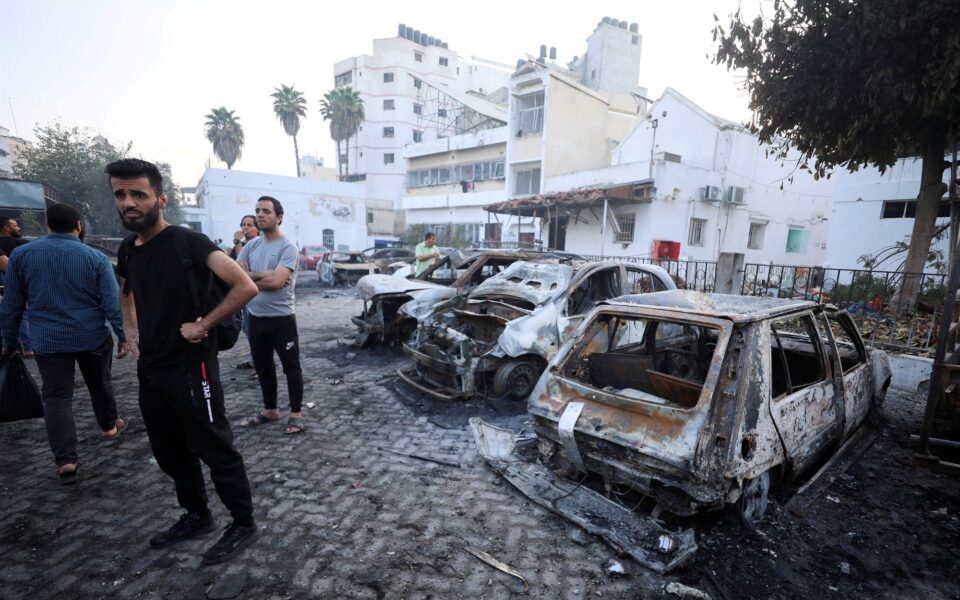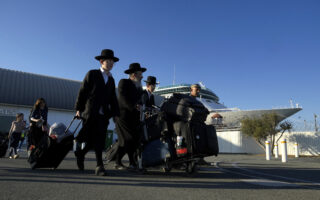How the media got the Gaza hospital explosion wrong

On the evening of October 17, the most prominent news organizations in the world spread word about a terrible tragedy unfolding in the Gaza Strip. Images of a blast at a hospital were beginning to circulate on social media. Hamas sources claimed that Israel was responsible for the death of over 500 civilians. But with details as yet extremely murky, it was impossible to tell who had caused the explosion or how many people had died. And yet, the most reputable names in news decided to use push alerts to spread Hamas’ claims far and wide.
“Hundreds feared dead or injured in Israeli air strike on hospital in Gaza, Palestinian officials say,” wrote the BBC. “Hundreds of people may have been killed in an Israeli strike on a Gaza City hospital, according to the Palestinian health ministry,” wrote CNN. “At least 500 people were killed by an Israeli airstrike at a Gaza hospital, the Palestinian Health Ministry said,” wrote The New York Times.
All three news outlets ascribed these facts to Palestinian authorities, thereby doing a bare minimum to ensure that they would not be on the hook for the veracity of these claims. And yet, all three push alerts would have led reasonable readers to conclude that these claims must basically be true. All of them talked about “Israeli” airstrikes. All of them uncritically reported that hundreds had died. None of them explained that the relevant authorities in the Gaza Strip are controlled by Hamas, the Islamist organization that had just killed over 1,400 Israeli civilians in a surprise attack.
News of the supposed Israeli strike quickly had huge real-world consequences. King Abdullah of Jordan canceled a planned meeting with President Joe Biden. Vast protests broke out in cities across the Middle East, some culminating in attacks on foreign embassies. In Germany, two unknown assailants threw Molotov cocktails at a synagogue in central Berlin. A wider regional war seemed to inch ever closer.
But as more details about the blast emerged, the initial claims so credulously parroted by the world’s leading news outlets increasingly came to look untenable. Videos circulating on social media indicated that the rockets likely emanated from Palestinian territory. Israel released credible recordings of Hamas operatives discussing the blast as the misfire of a rocket from Islamic Jihad. When day broke, new pictures of the site showed a very small crater more consonant with a misfired Palestinian projectile than an Israeli missile. It even came to look doubtful that the missile had directly hit the hospital. As one BBC team investigating the blast admitted, “images of the ground after the blast do not show significant damage to surrounding hospital buildings.”
By Wednesday morning, a new consensus started to emerge among experts. “The evidence this morning, though NOT conclusive by any means, points more towards a failed rocket launch than an Israeli air strike,” Shashank Joshi, the defense editor of The Economist, wrote. By the evening, security agencies had analyzed all the newly available evidence, and come to an even more confident verdict: “We feel confident that the explosion was the result of a failed rocket launch by militant terrorists and not the result of an Israeli airstrike,” Mark Warner, the chairman of the Senate Intelligence Committee, wrote.
It is now virtually certain that the cause of the tragedy was the opposite of that which news outlets around the world initially reported. Far from being a deliberate Israeli attack on civilians, it was a result of terrorists’ rank disregard for the lives of the people on whose behalf they claim to be fighting.
This means that the Palestinians who died at the hospital in Gaza should be added to the already grim death toll for which Hamas is responsible since its surprise attack on Israeli civilians. It also makes the credulous reporting by the world’s most influential media outlets one of the most consequential failures in recent media history. As Ted Lieu, a progressive member of the House of Representatives, points out, the “news organizations not only got it wrong” in spectacular fashion; “their rush to judgment caused other nations to wrongly interpret the hospital blast.”
So how could the media get things so badly wrong?
Misinformation mess
There are at least three reasons why the media messed up in such a colossal way.
Covering such an important developing story is genuinely hard. When an event is breaking all over social media, it is seemingly impossible for newspapers to abstain from saying anything at all. But when they do say something, they risk spreading the very misinformation they supposedly abhor.
Traditional news outlets also need to modernize how they analyze complicated events as they unfold. Over the last years, the use of open-source intelligence, which analyzes freely accessible data such as videos posted on social media accounts, has become vastly more refined. But most media outlets have not sufficiently invested in teams that are expert at such analysis, or hesitate to trust its members when the stakes are high. “The result is most mainstream news orgs today are either simply not equipped to determine for themselves what’s happening in some of the world’s biggest stories, or lack the confidence to allow their in-house technical specialists to cast doubt on a star reporter’s trusted source,” writes John Burn-Murdoch, the chief data reporter for the Financial Times.
As more details about the October 17 blast in Gaza emerged, the initial claims so credulously parroted by the world’s leading news outlets increasingly came to look untenable
But in light of the totality of news coverage over the days since the strike, it is very hard to resist that another factor is also at play: bias.
One reason to suspect bias is the stark contrast between the media’s rush to report Hamas’ claims about the hospital bombings and its extreme sluggishness in reporting on Hamas’ massacre of over 1,400 Israelis. Even when it had already become amply evident that Hamas terrorists had killed scores of Israeli civilians, most American papers reported on the unfolding events in extremely anodyne terms. Even hours after world leaders such as Joe Biden, Justin Trudeau and Emmanuel Macron had condemned the terrorist attacks, push alerts from America’s leading papers continued to talk, in vague terms, about “ground assaults.” “Gaza Militants Launch Surprise Attack on Israel,” the Wall Street Journal wrote on its website on the morning of October 7. “Gaza and Israel Go to War After Militants Launch Attacks,” The New York Times wrote at the same time.
Social media
Social media outlets are deeply imperfect. X, in particular, has in some ways become even less reliable since Elon Musk took over the platform. The worst information you encounter on the platform is much more irresponsible than anything that legacy media outlets produce.
And yet, the truth of it is that, for much of the past two weeks, these social media platforms were a crucial resource – one that has made traditional news outlets look like sluggish dinosaurs at best and like active sources of misinformation at worst. In the hours after Hamas attacked Israel, and again in the hours after a stray rocket hit the hospital in Gaza, an intelligent reader was much more likely to gain an accurate sense of the unfolding events by spending 10 minutes on X than by spending 10 minutes reading the world’s most storied news brands.
This helps to explain why trust in traditional media has been falling precipitously.
Journalists and media executives understandably like to blame others for their failings. If people no longer trust quality outlets, the fault must lie with the “misinformation” they encounter on social media. But such an easy allocation of blame won’t work when, marching in seeming unison, major news outlets mess up in as blatant and consequential ways as they have over the course of the past few days.
To do better, journalists will simultaneously have to learn to slow down and to speed up. In the initial rush to judgment, when the fog of war makes it genuinely impossible to know what is going on, they must be much more judicious in how they present information to their readers. To push glorified Hamas press releases to the phones of millions of Americans is the height of irresponsibility, even if journalists append a perfunctory hedge like “the Palestinian Health Ministry says.”
But even as newspapers need to slow down their initial response to breaking events, they must speed up their ability to offer readers clear guidance once meaningful information becomes available. There simply is no good reason why intelligent readers should find it so much easier to unearth smart analysis of unfolding events on social media platforms than in the pages of leading newspapers. They need, as Burn-Murdoch suggests, to invest more heavily in teams capable of using open-source intelligence. They need to feature more outside experts in live feeds on breaking news events. And they need to be more willing to make calls once the evidence is clearly pointing in one direction.
All of that, however, will be of no use if legacy media outlets are unwilling to speak inconvenient truth once they have become apparent. In that sense, the most depressing failure of the 48 hours after the event did not come in the immediate aftermath of the explosion at the hospital, when outlets made the grievous mistake of making the world think that Israel had caused the deadly strike. It came when the expert consensus started to point to a rocket by Islamic Jihad, but these same newspapers did not do nearly as much to correct the initial error they had helped to spread around the world.
“News organizations that immediately took the word of a Hamas-controlled entity falsely accusing Israel of striking the hospital should apologize,” Lieu, the progressive Democrat, tweeted last Wednesday. I am not holding my breath. But unless and until they do, it is hard to imagine that operational changes like an increased budget for teams analyzing open-source intelligence will help to win back the rapidly falling trust of their readers.
Yascha Mounk is associate professor at Johns Hopkins University. He regularly writes for newspapers and magazines including The New York Times, the Wall Street Journal, The Atlantic, Foreign Affairs, Slate, and Die Zeit.





